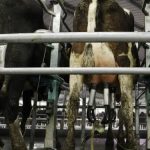
A farm in Morrinsville, 32km northeast of Hamilton, has been testing out solar-powered, GPS-enabled collars for cows, dubbed Halter, for over three years.
Now, a select number of dairy farms in Waikato are the first cohort in the world to try out the kiwi-startup software.
The founder, just 26, has a mechanical engineering degree and a job with Rocket Lab under his belt.
Craig Piggott, who grew up on a dairy farm in Waikato, is on the cusp of rolling out his initiative nationwide.
Farmers can now shift, manage and monitor their herds from the comfort of their home, saving up to three hours of work each day.
Farmers set up schedules and have the cows meet them at the milking shed, receive alerts when cows are on heat, calving or lame, and set up virtual fences to keep cows out of rivers and drains. It uses technology called Cowgorithim.
Piggott said the collar guides the cows around the farm using sounds and vibrations cues. The sounds tell them where they can’t go and the vibrations let them know where they can go – it’s fenceless, remote farming.
“It picks up sickness, heat, any major event and even when the cow is walking, sleeping or standing. It sends the information back to the farmer via the Halter app.
“As an industry, running a farm is pretty tough and there hasn’t been a lot of change in a long time… people can come in and milk cows and do those simpler tasks but those critical ones, like detecting heat, pastoral management and animal welfare can be tough, this software takes a step in the right direction.”
It can take up to two weeks for cows to become accustomed to the technology.
Business development manager Steve Crowhurst said its important farmers have the support they need when they integrate the new product.
“It’s great showing farmers the app… you can basically shift the cows to the shed in the morning by a press of a button… you don’t have to walk behind the cows anymore, you don’t have to put up fences,” Crowhurst said.
“Cows are generally happier because they’re not getting chased down by a motorbike or a dog, they can walk to the cowshed effectively at their own pace, but they are prompted.”
Dairy farms outside the Waikato can expect Halter to roll out to other regions by next year.
Luke O’Neil, who runs a 75-hectare farm in Ngatea has been trialling the software since June and said the ability to move multiple herds at once, from the warmth of the house is “pretty pleasing”.
“A lot of farmers are a bit sceptical because the idea that you can be inside and shift your herd is a little unbelievable,” O’Neil said.
“I spent a massive amount of time standing in the paddock watching, but it was from my own interest and intrigue rather than my need to be there.
“Initially the cow doesn’t’ know what you’ve put around its neck, so the first 10 to 14 days there’s quite a set pattern on how you use the collar to introduce it to the cow.
“It has really changed the way things are done and it’s going to change the way things are done.”

Cows on-farm will each wear a Halter collar, enabling farmers to shift, manage and monitor their herds remotely.
























